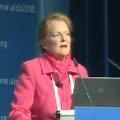The success of PEPFAR – the President's Emergency Plan for AIDS Relief – depends in large part on healthcare workers in African countries. But there's a shortage of those workers, as many leave for better opportunities elsewhere. As a result, PEPFAR has a new program to try to solve the problem. The issue was addressed at the 18th International AIDS Conference in Vienna.
The new phase of PEPFAR – known as PEPFAR II - calls for extending treatment to more than four million patients, preventing 12 million new infections and providing care for 12 million people living with HIV.
“To meet these goals, PEPFAR will need to support the training of large numbers of new healthcare workers in order to deliver the services,” says Deborah von Zinkernagel, the principal deputy U.S. global AIDS coordinator.
Train and retain She says, “We have a legislative mandate in the second phase of PEPFAR to increase the number of healthcare workers in the workforce by 140,000. And what is meant with that, there was an emphasis placed on training and deployment of doctors and nurses, as well as other professionals and paraprofessionals. And to look at that within the context as well of recruitment and retention issues and the larger dynamics, which are impacting the workforce.” For example, many doctors and nurses who are trained in Africa often leave the continent for higher pay and better opportunities abroad. “The issues have been raised today that you can train and train and train and if people are leaving and leaving – or they train and there's no job to go to – you haven't really looked at the policy environment in which you're providing educational services,” she says. Von Zinkernagel says PEPFAR II also calls for supporting the training institutions themselves.
“The Medical and Nursing Education Partnership Initiative is $20 million set aside this year to expand the clinical capacity and clinical quality of African medical and nursing schools and to strengthen these institutions in their mission.” To help retain the faculty at medical schools, more opportunities for research and advancement will be offered. The first part of the plan provides U.S. funding for up to nine African medical schools working in partnership with U.S. medical schools and universities. And eventually there will be two coordinating centers that will bring together doctors and nurses from across the continent to share lessons learned.

